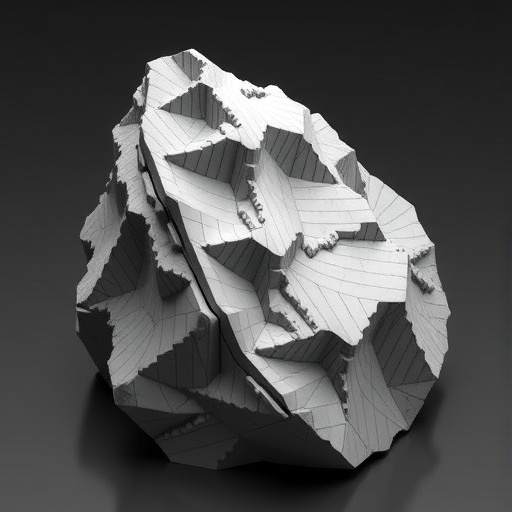In an era where modeling the behavior of natural materials is becoming increasingly critical for both engineering and environmental applications, the challenge of accurately simulating jointed rock masses has taken center stage in geotechnical research. A recent groundbreaking study by Meng, Shi, Zhang, and colleagues has introduced a novel computational advancement that promises to transform the way researchers and engineers approach the discrete-element-modeling (DEM) of complex fractured rock structures. This pioneering research presents a constrained meshing technique aimed at enhancing the fidelity and efficiency of DEM simulations in jointed rock masses.
Jointed rock masses, which comprise discontinuities such as fractures, joints, and faults, present formidable challenges for numerical modeling due to their inherent heterogeneity and intricate geometrical configurations. Traditional DEM approaches often struggle with the computational demand and accuracy required to account for these discontinuities meticulously. The novel approach put forth by Meng et al. addresses this pivotal limitation by developing a constrained meshing technique that preserves the integrity of joint networks while ensuring computational tractability.
At the heart of this innovation lies the strategic integration of geometry-conforming meshes with discrete element frameworks, allowing for a more precise numerical representation of rock discontinuities. Unlike conventional DEM approaches that approximate joint boundaries with oversimplified tessellations, the constrained meshing technique adheres strictly to joint geometries. This preserves the native mechanical interactions and fracture network complexities, providing a more realistic simulation of rock mass behavior under various stress regimes.
The merits of this approach are multifaceted. First, the method significantly reduces mesh distortion that typically plagues DEM models with complex joint patterns, thereby enhancing numerical stability and convergence characteristics. Second, by imposing geometric constraints during mesh generation, the researchers ensure that the elements align accurately with the joints, which is crucial for capturing stress redistributions and potential failure mechanisms. Consequently, this approach results in simulations that yield higher predictive accuracy for critical geomechanical phenomena such as crack propagation, shear sliding, and block rotation.
Computational experiments demonstrated in the study underscore the robustness of the constrained meshing technique. The authors conducted benchmark tests comparing traditional DEM methods with their new approach across various jointed rock configurations. Results highlighted not only enhanced simulation fidelity but also considerable computational efficiency gains. This is particularly noteworthy for large-scale geotechnical projects where computational resources often become bottlenecks.
Furthermore, the constrained meshing approach enables a seamless transition between different scales of analysis, bridging microscale joint interactions with macroscale rock mass responses. This multiscale modeling capability opens new avenues for examining rock behavior in a more integrated fashion, accommodating localized discontinuities while maintaining global mechanical coherence within the rock mass.
The implications of this research extend well beyond academic curiosity. Real-world engineering projects, such as underground tunneling, slope stability analysis, and reservoir modeling, require dependable simulations of jointed rock masses to mitigate geohazards effectively. The ability to model these complex systems rigorously translates directly to safer designs, reduced construction costs, and improved resource extraction efficiency.
Importantly, the paper delves into the algorithmic intricacies underpinning the constrained meshing procedure. By utilizing advanced spatial partitioning algorithms combined with iterative refinement, the technique automatically adapts the mesh to conform to existing joints without user intervention. This automation significantly advances usability, making the model accessible to practitioners who might otherwise face steep learning curves with meshing software.
Notably, the constrained meshing method also enables the incorporation of realistic joint mechanical properties, including varied stiffness, frictional behavior, and potential damage evolution. This adaptability ensures that the model can capture the true heterogeneity of natural rock masses, reflecting the diverse material characteristics observed in field conditions.
An exciting aspect of this development is its compatibility with OpenDEM software environments, promoting wider dissemination and collaborative improvements within the geotechnical community. By embracing open-source platforms, the research team fosters innovation and ensures that this advanced technique becomes a stepping stone for future DEM enhancements.
From a theoretical standpoint, this research revitalizes discrete-element modeling paradigms by bridging the conventional gap between mesh generation and mechanical property assignment. The constrained meshing approach exemplifies how integrating geometric constraints into discrete element frameworks can yield models that realistically replicate fracture network dynamics, an essential feature in rock mechanics.
Moreover, the study meticulously validates the proposed method against experimental data from rock mechanics laboratories, enhancing confidence in simulation results. The correlation between predicted fracture patterns, joint opening behaviors, and experimental observations confirms the method’s reliability and practical relevance.
Looking ahead, this research opens promising pathways for incorporating more complex joint behaviors, such as time-dependent fracture growth and coupled hydro-mechanical interactions, which remain critical frontiers in rock engineering. The constrained meshing technique provides a solid foundation upon which such multifaceted modeling advancements can be built.
In conclusion, the work by Meng and colleagues heralds a new chapter in discrete-element rock mechanics modeling. By pioneering a constrained meshing technique tailored to the complexities of jointed rock masses, they have paved the way for simulations that combine unprecedented accuracy with computational efficiency. This breakthrough not only elevates our fundamental understanding of fractured rock behavior but also equips engineers and scientists with powerful tools to tackle some of the most pressing challenges in earth science and infrastructure development.
Subject of Research: Modeling jointed rock masses using discrete element methods with a constrained meshing technique.
Article Title: A novel discrete-element-method (DEM) for jointed rock masses: constrained meshing technique.
Article References:
Meng, Qx., Shi, Pc., Zhang, Jc. et al. A novel discrete-element-method (DEM) for jointed rock masses: constrained meshing technique. Environ Earth Sci 84, 592 (2025). https://doi.org/10.1007/s12665-025-12636-z
Image Credits: AI Generated




